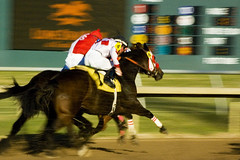Part I of III in the 'How Does This Camera Work' section:
Back in the cave man days, film was divided into sensitivity levels using the ASA - ISO method. The higher the number, the higher the sensitivity to light. Film could range from 25 ISO to 3200 ISO and beyond. And each type had their own uses in photography. The
trade off to sensitivity was the size of the film grain. The more sensitivity you needed, the bigger the grain and the more grainy your photo looked.
For many new photographers, this is a huge concern. Just do a
Google search and see the debates that rage over ISO sensitivities and comparisons between models, etc. Each time I asked a professional photographer about it, they just laughed and patted me on the head. One of them said, "Young grasshopper, you have much to learn. Forget about ISO and get the shot." My photography instructor said, "There was a famous photographer that took photos of NFL players in the 60s. He was using some ridiculously high ISO film. The grain was as big as beach balls and they still put his images on the side of buildings in Times Square."
Coming from a large format printing background I was concerned with grain because many of my images were being blown up to 80" on the short dimension and grain became plainly clear. And approximately a year later I learned. They were all correct. The age old photojournalists' phrase, "f8 and be there," has some real merits.
Now, one thing about ISO (and something you will find relates to a lot of photography) is you can use it precisely to properly exposure your photos. It does follow a bit of arcane methodology and wording, but I think you can pick it up. Lines of demarcation in photography happen when taking about light in terms of "stops". Each stop allows 100% more light into the camera than the stop before it. And it allows half as much light as the stop after it. Therefore, film that is 100 ISO is half as light sensitive as 200 ISO film. And 200 ISO film is half as sensitive as 400 ISO film. etc. There are half stops and, with digital cameras, 1/3rd stops, but, once you understand these rules, the fractions make sense in the big swing of things.
When trying to determine exposure for an image, as mentioned in other posts, you need to factor in 3 aspects: the amount of light hitting the sensor, the duration of time that it is allowed to hit it, and the sensitivity of the sensor itself.
ISO deals with the sensitivity of the sensor. Lets say you were exposing an image using a photograph that was taken with an
aperature of f8 and an exposure of 1/60
th of a second. Let's also say you used a sensor sensitivity of 100ISO. Later, when you looked at the image in your favorite digital imaging program (
Lightroom,
Photoshop, Etc) You notice it is under exposed. You'd like to raise the exposure one stop. One option is raising your ISO from 100 to 200. This will double the amount of light allowed onto the final image. If you still think it is underexposed, you can raise the ISO to 400. This allows double the amount of light sensitivity as ISO 200 did.
Having said all that, do I think ISO matters at all? Sure it does. It matters if you're comparing a Nikon D40 to a Nikon D3, or a
Rebet Xti to a 5D. A cropped sensor (what most SLR cameras have) compared to a full frame sensor is hardly a fair ISO fight. And if you have the need, (something most people don't) and the funds, ( something more people have, than the need) major shifts in ability are worth noting. But, one stop of improvement between this
CMOS sensor compared to this
CCD sensor
isnt. Spend that time shooting photos, experimenting, learning something new about lighting or composition, or looking at other people's photography and learning from it. One major problem with "pro-
sumer" photography is that people think the equipment is inferior. 9 times out of 10, it's not. To borrow a phrase from the auto racing community. The main part that needs improvement is usually the nut behind the wheel.












